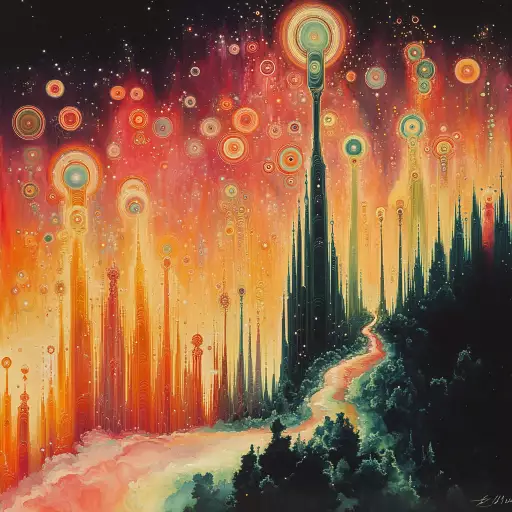Explore the Best AI Image Gallery

Reimagining Creation: How AI-Powered Visual Experiences are Transforming the Creative Industry
The realm of creativity is undergoing a seismic shift, propelled by the burgeoning field of artificial intelligence (AI). AI-powered visual experiences are no longer a futuristic fantasy; they are reshaping how we create, consume, and interact with art, design, and media. From generating breathtaking visuals to personalizing user journeys, these innovative technologies are democratizing creativity and unlocking unprecedented possibilities.
A New Canvas for Artistic Expression
AI algorithms are empowering artists to transcend traditional limitations, serving as collaborative tools that augment human imagination. Generative adversarial networks (GANs) can create stunningly realistic images, abstract art, and even 3D models, while AI-powered design software assists in generating concepts, refining layouts, and automating tedious tasks. This fusion of human ingenuity and artificial intelligence opens up exciting avenues for experimentation and exploration.
Immersive Experiences Redefined
AI is revolutionizing the way we experience visual content through immersive technologies like augmented reality (AR) and virtual reality (VR). AI-powered AR applications can overlay digital information onto the real world, enhancing our understanding of environments and creating interactive experiences. In VR, AI can generate dynamic and personalized worlds, adapting to user actions and preferences. This convergence of AI and immersive technologies promises to transform entertainment, education, and even social interactions.
Beyond Aesthetics: The Power of Personalization
AIs ability to analyze vast datasets allows for highly personalized visual experiences. Algorithms can learn individual preferences, tailor content recommendations, and create customized designs that resonate with specific users. This level of personalization is transforming marketing campaigns, e-commerce platforms, and even educational materials, making them more engaging and impactful.
Ethical Considerations: Navigating Uncharted Territory
The rapid advancements in AI-powered visual experiences raise important ethical considerations. Issues surrounding bias in algorithms, the ownership of AI-generated content, and the potential for misuse require careful attention. It is crucial to develop guidelines and regulations that ensure responsible development and deployment of these technologies, safeguarding against unintended consequences.
Future Trends: A Glimpse into Tomorrow
The future of AI-driven visual experiences holds immense promise. We can expect to see:
- More sophisticated AI algorithms capable of generating even more realistic and creative content.
- Wider adoption of immersive technologies like AR and VR, integrated into everyday life.
- Increased personalization, with AI tailoring visual experiences to individual needs and preferences.
- New forms of artistic expression, blurring the lines between human and machine creativity.
As AI continues to evolve, its impact on the creative industry will only intensify. By embracing these advancements responsibly and ethically, we can unlock a future where technology empowers artists, designers, and individuals to create, explore, and connect in unprecedented ways.




















![**Representation: A dog acting as a private tutor to a child. The dog holds a ruler in its paw and stands at the blackboard to explain a dog diagram to the child. Graphic style: Line drawing, cartoon style, influenced by Franco-Belgian comics, thick black lines, simplified design, vector, black and white only, in the style of Keith Haring or the French comic strip "Alinéa". [IMPORTANT]: A single continuous line extending from one side of the image to the other, minimalist, strong outlines, line drawing, without lifting the hand, ultra-simplified, no shading, entirely white image, drawing created in the center of a sheet of paper. --ar 16:5** - <@627984126871470085> (fast)](https://images.ai-img.art/thumbnails/150/7a854648a81e51241dcca8d24dd6e3bfcf07ad1df51baf401c9b729f4cf411fa.webp)







](https://images.ai-img.art/thumbnails/150/157712d76865d557120f9baf988de3d0525225295a2789c89bf2c4a5a96a03d1.webp)


![**Representation: A teenager smiling while thinking about a friendly dog, a comic-style thought bubble with a friendly dog inside. Graphic style: Line drawing, cartoon style, influenced by Franco-Belgian comics, thick black lines, simplified design, vector, black and white only, in the style of Keith Haring or the French comic strip "Alinéa". [IMPORTANT]: A single continuous line extending from one side of the image to the other, minimalist, strong outlines, line drawing, without lifting the hand, ultra-simplified, no shading, entirely white image, drawing created in the center of a sheet of paper. --ar 16:5** - <@627984126871470085> (fast)](https://images.ai-img.art/thumbnails/150/6fc850f638e3dee0c4b121acecad2c8419e02bdeac7f871d625f1003c1c3abe1.webp)
](https://images.ai-img.art/thumbnails/150/51c93500396faff4e7fa8b42bc68033067b16b2230e3496e95c482a581ff0fe9.webp)

](https://images.ai-img.art/thumbnails/150/9d51c5e673b4f2068b7b01abc35425a06f173b76303adf9ad29ca14302c25b18.webp)


![**Representation: A dog acting as a private tutor to a child. The dog holds a ruler in its paw and stands at the blackboard to explain a dog diagram to the child. Graphic style: Line drawing, cartoon style, influenced by Franco-Belgian comics, thick black lines, simplified design, vector, black and white only, in the style of Keith Haring or the French comic strip "Alinéa". [IMPORTANT]: A single continuous line extending from one side of the image to the other, minimalist, strong outlines, line drawing, without lifting the hand, ultra-simplified, no shading, entirely white image, drawing created in the center of a sheet of paper. --ar 16:5** - Variations (Strong) by <@627984126871470085> (fast)](https://images.ai-img.art/thumbnails/150/f4e034998ccd869d8a061fd12017514fcd92210eb33d4222dc9b54716223f4dd.webp)






